
The United States Navy Sea, Air, and Land (SEAL) Teams, commonly known as Navy SEALs, are the U.S. Navy's primary special operations force and a component of the Naval Special Warfare Command. Among the SEALs' main functions are conducting small-unit special operation missions in maritime, jungle, urban, arctic, mountainous, and desert environments. SEALs are typically ordered to capture or kill high-level targets, or to gather intelligence behind enemy lines. SEAL team personnel are hand-selected, highly trained, and possess a high degree of proficiency in unconventional warfare (UW), direct action (DA), and special reconnaissance (SR), among other tasks like sabotage, demolition, intelligence gathering, and hydro-graphic reconnaissance, training, and advising friendly militaries or other forces. All active SEALs are members of the U.S. Navy.

A frogman is someone who is trained in scuba diving or swimming underwater in a tactical capacity that includes military, and in some European countries, police work. Such personnel are also known by the more formal names of combat diver, combatant diver, or combat swimmer. The word frogman first arose in the stage name the "Fearless Frogman" of Paul Boyton in the 1870s and later was claimed by John Spence, an enlisted member of the U.S. Navy and member of the OSS Maritime Unit, to have been applied to him while he was training in a green waterproof suit.

A diver propulsion vehicle (DPV), also known as an underwater propulsion vehicle, sea scooter, underwater scooter, or swimmer delivery vehicle (SDV) by armed forces, is an item of diving equipment used by scuba divers to increase range underwater. Range is restricted by the amount of breathing gas that can be carried, the rate at which that breathing gas is consumed, and the battery power of the DPV. Time limits imposed on the diver by decompression requirements may also limit safe range in practice. DPVs have recreational, scientific and military applications.
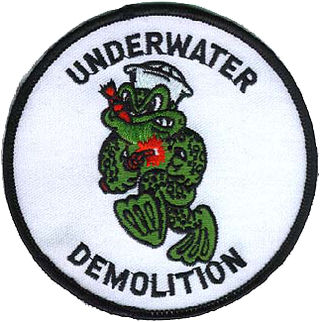
The Underwater Demolition Team (UDT), or frogmen, were amphibious units created by the United States Navy during World War II with specialized missions. They were predecessors of the navy's current SEAL teams.

The SEAL Delivery Vehicle (SDV) is a crewed submersible and a type of swimmer delivery vehicle used to deliver United States Navy SEALs and their equipment for special operations missions. It is operated by SEAL Delivery Vehicle Teams.

The United States Naval Special Warfare Command (USNSWC), also known as NAVSPECWARCOM and WARCOM, is the naval component of United States Special Operations Command, the unified command that oversees and conducts the nation's special operations and missions.
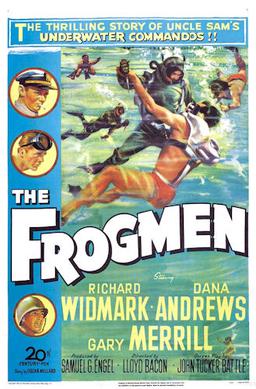
The Frogmen is a 1951 American black-and-white World War II drama film from Twentieth Century Fox, produced by Samuel G. Engel, directed by Lloyd Bacon, that stars Richard Widmark, Dana Andrews, and Gary Merrill. The film's storyline is based on operations by United States Navy Underwater Demolition Teams, popularly known as "frogmen", against the Japanese Army and naval forces. It was the first such film about scuba diving and became a popular cultural hit.

The Kopaska is the premier frogman and underwater demolition unit of the Indonesian Navy. The unit's motto is Tan Hana Wighna Tan Sirna. The unit's main duties are underwater demolition, destroying main underwater installations, reconnaissance, prisoner snatches, preparing beaches for larger naval amphibious operations, and counter-terrorism. During peacetime, the unit also deploys a team to serve as security personnel for VIPs and VVIPs. The personnel of Kopaska are recruited from Indonesian Navy seamen. Like other Indonesian special forces, Kopaska is trained to be able to conduct operations in the sea, including underwater, on land and airborne.
Someone Special was the official U.S. Navy recruiting film for the U.S. Navy SEALs during the Vietnam War era. This film was shown to all U.S. Navy recruits during their recruit training, and it was designed to motivate young sailors to volunteer for SEAL training.

Albert Melrose Calland III was a vice admiral in the United States Navy who was the deputy director for Strategic Operational Planning at the National Counterterrorism Center and commander of Naval Special Warfare Command from 2002 to 2004. He also previously served as Deputy Director of the Central Intelligence Agency from July 2005 to July 2006 and commanded the Naval Special Warfare Development Group from 1997 to 1999.

The Civil Engineer Corps (CEC) is a staff corps of the United States Navy. CEC officers are professional engineers and architects, acquisitions specialists, and Seabee Combat Warfare Officers who qualify within Seabee units. They are responsible for executing and managing the planning, design, acquisition, construction, operation, and maintenance of the Navy's shore facilities. The Civil Engineer Corps is under the command of the Chief of Civil Engineers and Commander, Naval Facilities Engineering Systems Command. On 12 August 2022, RADM Dean VanderLey relieved RADM John W. Korka, becoming the 46th commander of NAVFAC and Chief of Civil Engineers.

A wet sub is a type of underwater vehicle, either a submarine or a submersible, that does not provide a dry environment for its occupants. It is also described as an underwater vehicle where occupants are exposed to ambient environment during operations. The watercraft is classified as medium-sized or small vessel. This type of submarine differs from other underwater personal transport devices by the fact that it has a hull around it and it is not a "bare bones" design.
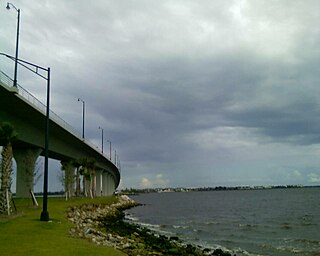
North Hutchinson Island is a coastal barrier island in Indian River and St. Lucie counties on the east coast of Florida in the United States. The island is adjacent to the Atlantic Ocean and is separated from the mainland on the west by the Indian River Lagoon. The portion of the island in Indian River County is known as Orchid Island.
Naval Special Warfare Group 3 (NSWG-3), based at the Naval Amphibious Base Coronado in California, was one of six constituent formations of the United States Naval Special Warfare Command. Until 2008, NSWG-3 was composed of two SEAL Delivery Vehicle Teams: SDVT-1 in Pearl Harbor and SDVT-2 in Little Creek. In 2008, SDVT-2 was disestablished and merged into SDVT-1, which was then now headquartered in Pearl Harbor and operated detachments in Pearl Harbor and Little Creek. SDV Teams are SEAL teams with an added underwater delivery capability. SDVT-2 was reactivated on 8 March 2019. NSWG-3 was deactivated alongside NSWG-10 in August 2021 and replaced by Naval Special Warfare Group 8 which took in all units previously under NSWG-3 and NSWG-10.

The US employs divers in several branches of the armed forces, including the navy, army, marines, air force and coast guard.
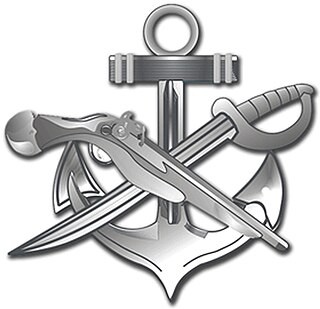
The Special Warfare Combat Crewmen (SWCC ) are United States Naval Special Warfare Command personnel who operate and maintain small craft for special operations missions, particularly those of U.S. Navy SEALs. Their rating is Special Warfare Boat Operator (SB).
Operation Thunderhead was a highly classified combat mission conducted by U.S. Navy SEAL Team One and Underwater Demolition Team 11 (UDT-11) in 1972. The mission was conducted off the coast of North Vietnam during the Vietnam War to rescue two U.S. airmen said to be escaping from a prisoner of war prison in Hanoi. The prisoners, including Air Force Colonel John A. Dramesi were planning to steal a boat and travel down the Red River to the Gulf of Tonkin.

The Republic of Korea Navy Special Warfare Flotilla is a special operations force of the Republic of Korea Navy. The WARFLOT is most commonly referred to as the Underwater Demolition Team or UDT, and sometimes as UDT/SEALs, coming from the fact UDTs are the most prominent branch of the flotilla and their close ties with US Navy SEALs respectively.
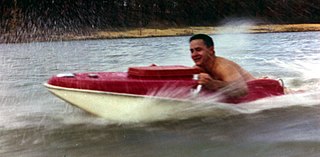
The Sea Skimmer was a leisure Personal Watercraft (PWC) unique within the family of Personal Watercraft, whereas the operator laid prone on the boat and steered with shifting leg motions and body weight to control the craft, reaching speeds up to 25 MPH. The Sea Skimmer preceded the modern Jet Ski / Sea Doo. It was transferred into classified Military service in 1962 with boats modified by Aqua Dart INC. It was instrumental in River Reconnaissance missions during the Vietnam war by the United States Naval Special Warfare Command.




















